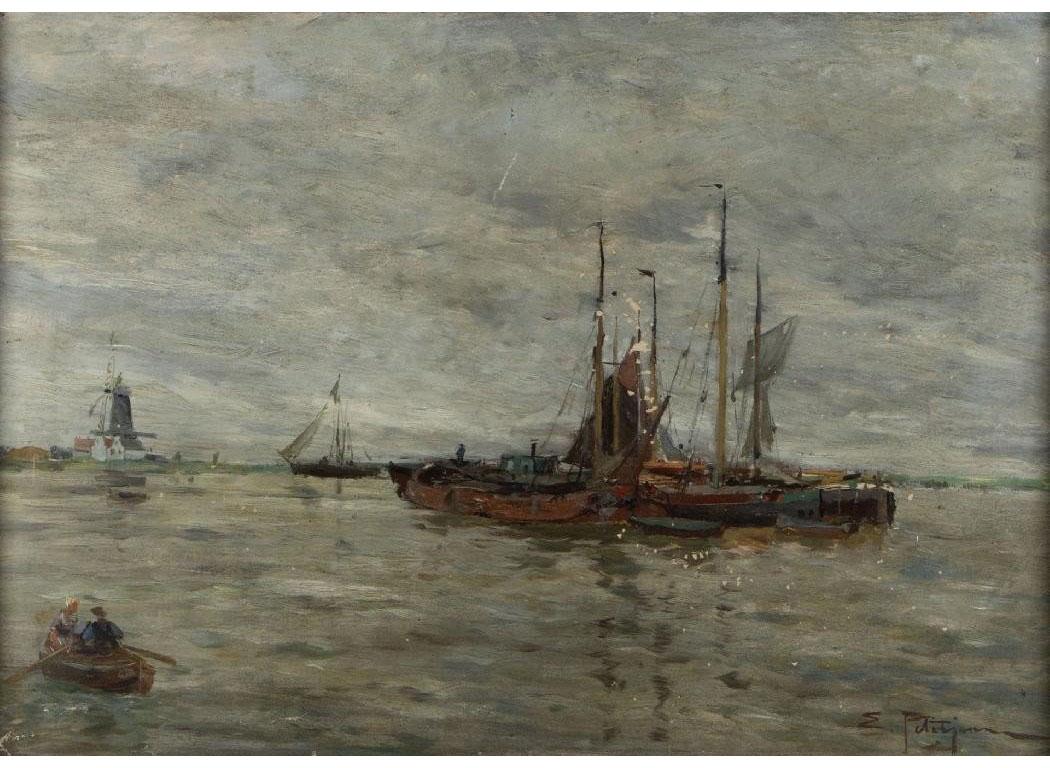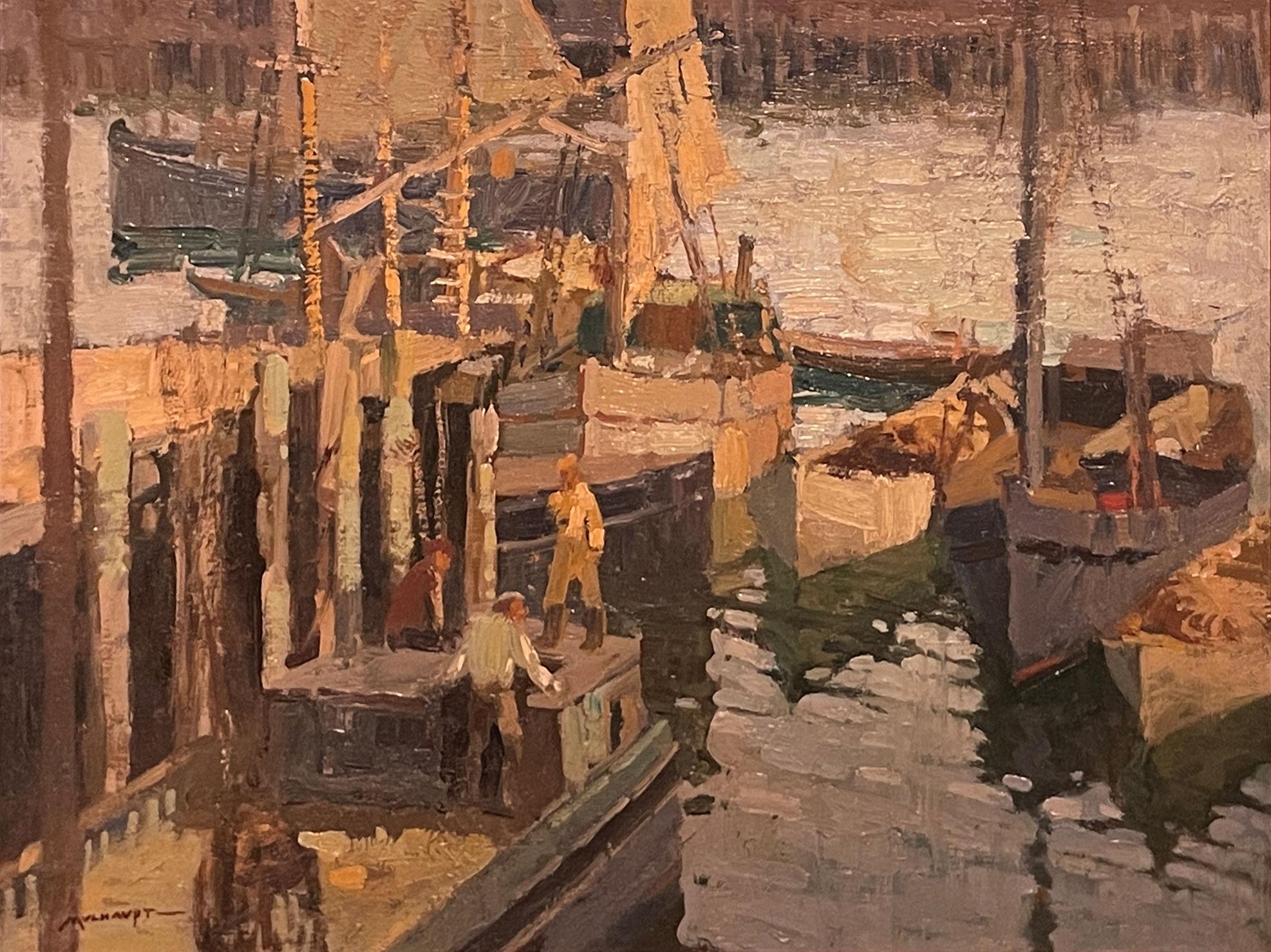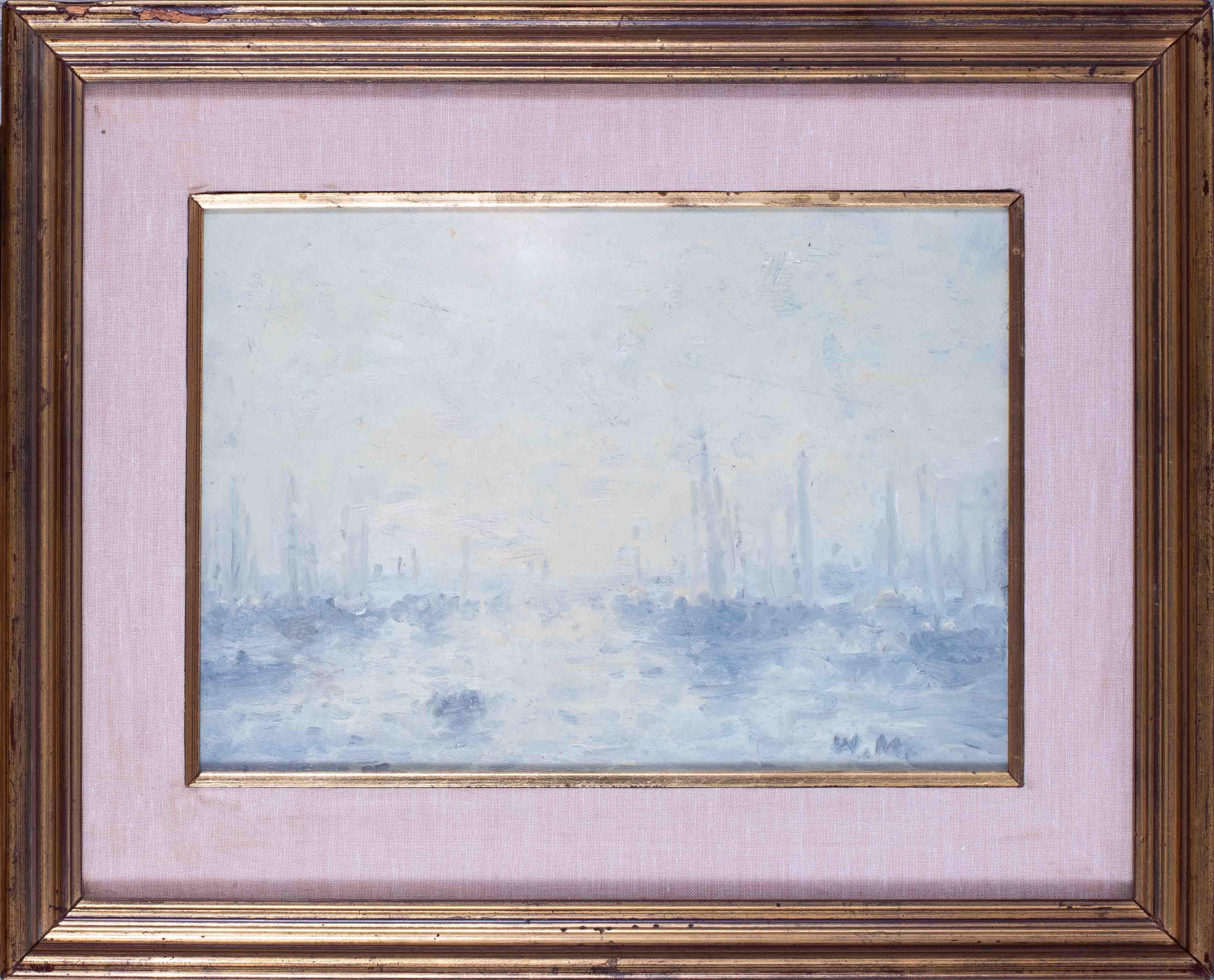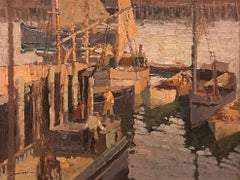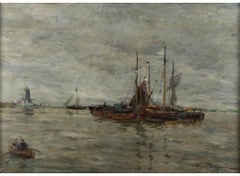Items Similar to "Soir de Novembre, Dordrecht, " Eugene Vail, Dutch Landscape with Boats, Cloudy
Want more images or videos?
Request additional images or videos from the seller
1 of 10
Eugène Lawrence Vail"Soir de Novembre, Dordrecht, " Eugene Vail, Dutch Landscape with Boats, Cloudy
$11,000
£8,402.92
€9,654.93
CA$15,727.64
A$17,328.19
CHF 8,970.12
MX$208,635.90
NOK 113,583.43
SEK 106,704.44
DKK 72,086.26
About the Item
Eugène Laurent Vail (1857 - 1934)
Soir de Novembre, Dordrecht
Oil on canvas
19 1/4 x 25 3/4 inches
Signed lower left; titled in two places on the stretcher with various other inscriptions, stamped "MADAME G:VAIL A" and inscribed "177" in ink and "#43" in pencil on a partial label from Garde-Meuble Maple affixed to the stretcher
Eugene Vail (Saint-Servan, France September 29, 1857 - Paris, December 28, 1934), the son of a French mother and an American father, Lawrence Eugene Vail, studied at the Stevens Institute of Technology in Hoboken, New Jersey (where Alfred Stieglitz was born in 1864) and graduated with a degree in mechanical engineering in 1877. Then he became a student of William Merritt Chase and J. Carroll Beckwith at the Art Students League before returning to France. He entered the Ecole des Beaux-Arts in 1882 where he was instructed by Alexandre Cabanel, Raphaël Collin, and Dagnan-Bouveret (1852-1929), known as an extreme naturalist. When Bastien-Lepage died in 1884, Dagnan-Bouveret became the leader of the Naturalist School. He definitely made an indelible impression on Vail.
According to Louise Cann, Vail soon became an independent painter working at Pont-Aven and Concarneau. It is difficult to determine when he separated from his teachers since he is listed as a student whenever he exhibited at the Paris Salon — that is, until 1899 when he dropped the mention of élève. A picture of a peasant girl, Seulette was his Salon debut painting in 1883, the same year that he sent two scenes of Brittany to the Pennsylvania Academy of the Fine Arts' exhibition, which documents his stay in that region.
The next year he exhibited in the Salon: Fishing Port, Concarneau, which went to the Luxembourg Museum (it is now in the Musée Municipal of Brest). It has the Naturalist brown and gray palette and tonalist atmosphere but already shows that Vail had direct experience with scenes of life in coastal villages: "So convincing was his familiarity with the French coast that the critic Thiébault-Sisson claimed him as a Frenchman and declared that no American marine painter could touch his skill." (Maureen C. O'Brien, in Blaugrund, 1989, p. 218).
In 1885, Vail exhibited Inner Port at Dieppe and in the following year On the Thames (Private collection), which later won him the Grand Diploma of Honor from an international jury in Berlin in 1891. Widow, the title of Vail's entry in the Salon of 1887 (unlocated), is a striking image of a woman standing on a beach, looking out to the expanse of the ocean where her husband obviously met his end. The innocent child who looks at us may have the same fate in store for him. Then in 1888, Vail completed his masterpiece, Ready, About! a "wall-size" 94 x 125½ inch canvas. The painting won a first-class gold medal in the Salon of 1888, then at the Paris Universal Exposition of 1889, Vail won another gold medal.
The first precedent that comes to mind is Théodore Géricault's colossal Raft of the Medusa of 1819 (Louvre), the celebrated romantic image of castaways about to be rescued after being lost at sea. But while Géricault presents a massive, sculpturesque group of figures struggling on a raft just beyond our designated viewing space, Vail pulls the viewer into the picture, or more exactly, extends the diagonally rocking boat into the spectator's area, vividly anticipating the effects of cinematography. There is no more effective way to engage the spectator's attention and sympathies, and the illusionism is especially effective in this life-size picture.
Vail's vigorous brushwork — a uniform use of rectangular strokes — adds to the motion-filled, dynamic actuality of this image, and the overall green-gray tonalities evoke the constantly menacing, cold and wet travails in the life of the fishermen in the Atlantic's rough waters. Theodore Child (1889, p. 518) wrote about this painting: "very beautiful in color, and amongst the very strongest and best pictures of this kind in the Exhibition."
Dordrecht (unlocated) was Vail's painting exhibited at the Pennsylvania Academy in 1892, and in the following year he showed Fisherman — The North Sea at the Paris Salon, the same year in which he re-exhibited Dordrecht and On the Thames at the World's Columbian Exposition in Chicago. Vail won the coveted Légion d'Honneur in 1894. Some of his paintings found their way to European museums, for example, Soir de novembre (Odessa Museum) and Soir de Bretagne (Museo d'Arte Moderna, Venice). The latter was exhibited at the Exposition Universelle of 1900 in Paris. Also there was Voix de la mer (Voices of the Sea), which we identify as the painting that appears in an interior view of the American section, just to the right of a doorway (fig. 20 in Fischer, 1999), a simple marine painting.
Some time after 1900, Vail turned to both impressionism and post-impressionism but no one seems to have charted this course. His Autumn near Beauvais, illustrated in International Studio (1902, p. 211), The Flags, St. Mark's Venice (1903; National Gallery of Art), and Grand Canal, Venice, ca. 1904 (Museum of Art, Rhode Island School of Design) demonstrate an impressionist technique with broken color. Mandel (1977, p. 202) wrote on the latter: "applied in short strokes juxtaposing brilliant hues of orange, blue, white, black and red, with a strong interplay between the warm pink tones of the walls and the green shadows of the black boats which are silhouetted against them." Cann (1937) believed that in Venice, Vail "found his true self." The Flags forecasts the Armistice Day pictures by Hassam and others, painted fifteen years later.
Vail became involved in the Society of American Artists in Paris and the Société Internationale de Peinture et de Sculpture, whose membership included Frank Brangwyn, Charles Cottet (1863-1924), the famous Naturalist sculptor Constantin Meunier (1831-1905), Frits Thaulow (1847-1906), the painter of northern snowscapes, Walter Gay, and the post-impressionists Henri Martin (1860-1943) and Henri Le Sidanier (1862-1939). The group was represented by the Galerie Georges Petit. Naturally, such an association encouraged the seeking out of more modernist directions.
In his Swiss mountain landscapes, Vail became more dynamic than ever, employing almost Fauvist brushwork. It seems unfortunate how a few American expatriate artists — Sargent and Whistler, for instance — have eclipsed great talents such as Eugene Vail. But when Vail passed away, the naturalist movement he was associated with was as dead as a doornail. Max Ernst published his surrealistic collage-novel, Une semaine de bonté and the exhibition called "Machine Art" opened at the Museum of Modern Art in New York, where critic Alfred Barr attempted to raise household appliances to the level of Neoplatonic beauty.
- Creator:Eugène Lawrence Vail (1857 - 1934, American)
- Dimensions:Height: 16.5 in (41.91 cm)Width: 19 in (48.26 cm)
- Medium:
- Movement & Style:
- Period:
- Condition:
- Gallery Location:New York, NY
- Reference Number:1stDibs: LU1841210510822
About the Seller
5.0
Platinum Seller
Premium sellers with a 4.7+ rating and 24-hour response times
Established in 2022
1stDibs seller since 2022
123 sales on 1stDibs
Typical response time: <1 hour
- ShippingRetrieving quote...Shipping from: New York, NY
- Return Policy
Authenticity Guarantee
In the unlikely event there’s an issue with an item’s authenticity, contact us within 1 year for a full refund. DetailsMoney-Back Guarantee
If your item is not as described, is damaged in transit, or does not arrive, contact us within 7 days for a full refund. Details24-Hour Cancellation
You have a 24-hour grace period in which to reconsider your purchase, with no questions asked.Vetted Professional Sellers
Our world-class sellers must adhere to strict standards for service and quality, maintaining the integrity of our listings.Price-Match Guarantee
If you find that a seller listed the same item for a lower price elsewhere, we’ll match it.Trusted Global Delivery
Our best-in-class carrier network provides specialized shipping options worldwide, including custom delivery.More From This Seller
View All"Gloucester Boats" Frederick Mulhaupt, Impressionist Gloucester Scene
Located in New York, NY
Frederick John Mulhaupt
Gloucester Boats
Signed lower left
Oil on board
12 x 16 inches
Born in Rock Port, Missouri, in 1871, Mulhaupt studied...
Category
Early 20th Century American Impressionist Figurative Paintings
Materials
Oil, Board
"Reflections, " Alexander Bower, Boats on the Water, American Impressionism View
By Alexander Bower
Located in New York, NY
Alexander Bower (1875 - 1952)
Reflections, Motif No. 1, Rockport, Massachusetts
Oil on canvas
22 x 18 inches
Signed lower right; titled on the stretcher
An American Impressionist, Alexande Bower was born in New York, studied at The Pennsylvania Academy of Fine Art, and was living with his wife in Cliff Island, Maine by 1914. Despite his urban upbringing, the coast and the sea fascinated Bower. A large portion of his paintings are seascapes, particularly scenes depicting the coast of Cape Elizabeth...
Category
Early 20th Century American Impressionist Landscape Paintings
Materials
Canvas, Oil
"Nantucket, Massachusetts" Helen Goodwin, American Impressionism Docks at Harbor
Located in New York, NY
Helen M. Goodwin (1865 - 1955)
Nantucket, Massachusetts
Oil on canvas laid on panel
12 x 16 inches
Signed and titled lower right
Helen M. Goodwin was born in New Castle, Indiana in ...
Category
Early 20th Century American Impressionist Landscape Paintings
Materials
Oil, Panel, Canvas
Bateau au Quai (Docked Sailing Vessel at Low Tide), Frank Myers Boggs, Landscape
By Frank Myers Boggs
Located in New York, NY
Frank Myers Boggs
Bateau au Quai (Docked Sailing Vessel at Low Tide)
Signed lower left
Oil on canvas
15 x 21 1/2 inches
Provenance:
David Findlay Galleries, New York
Charles R. Brown Fine Art, Locust Valley, New York
The Impressionist Frank Myers Boggs spent his formative and mature years abroad and in 1923 became a naturalized French citizen. He was born in Springfield, Ohio, but moved as a young boy to New York, where his father was a newspaper executive. The artist began his career at the age of seventeen as a wood engraver for Harper’s, preparing illustrations for Harper’s Weekly and for an American edition of the works of Charles Dickens. It has also been stated that he studied with the portraitist John Barnard Whittaker (1836–1926).
After working at Niblo’s Garden in New York with a scene painter named Vauglin, Boggs went to Paris to study scene painting. On his arrival there in 1876, he was unable to find anyone to instruct him in this field and instead entered the École des Beaux-Arts. Realizing that Boggs was not well suited to painting figurative subjects, his teacher Jean-Léon Gérôme (1824–1904) advised him to try some outdoor landscapes. Between 1877 and 1881, he concentrated on marine...
Category
Late 19th Century Impressionist Landscape Paintings
Materials
Canvas, Oil
"View of New York Harbor, Staten Island Ferry, " Gustave Wolff, Impressionism
By Gustave Wolff
Located in New York, NY
Gustav (Gustave) Wolff (1863 - 1935)
View of New York Harbor from the Staten Island Ferry
Oil on canvas
16 x 12 inches
Signed lower right
In the Autumn of 1913, the German Associati...
Category
Early 20th Century American Impressionist Landscape Paintings
Materials
Canvas, Oil
"Gloucester Harbor" Laura Woodward, Cape Ann Marine Scene, Hudson River School
By Laura Woodward
Located in New York, NY
Laura Woodward
Gloucester Harbor, circa 1880
Signed lower left
Oil on canvas
18 x 24 inches
Provenance:
Private Collection, United Kingdom
Priory Fine ...
Category
1880s American Impressionist Figurative Paintings
Materials
Canvas, Oil
You May Also Like
Oil Painting by Edmund Aubrey Hunt "A Dutch Estuary, Evening"
Located in Mere, GB
Oil Painting by Edmund Aubrey Hunt "A Dutch Estuary, Evening" 1855- 1922 Massachusetts painter who studied under Gerome in Paris who then settled in London. Exhibited at the Royal Ac...
Category
19th Century Landscape Paintings
Materials
Oil
Harbor Scene with Boats
By Louis Abel-Truchet
Located in Milford, NH
A fine impressionist coastal painting with boats in the harbor and a cabbage garden in the foreground by French artist Louis Abel-Truchet (1857-1918). Louis Abel-Truchet was born in ...
Category
Late 19th Century Impressionist Landscape Paintings
Materials
Canvas, Oil
Three Sailboats At Anchor, View Of Holland, oil on canvas, signed lower right
Located in PARIS, FR
Edmond Marie Petitjean was a French painter and illustrator born on July 5, 1844, in Neufchâteau (Vosges) and died on August 7, 1925, in Paris.
Biography
A painter of landscapes and...
Category
Late 19th Century Impressionist Landscape Paintings
Materials
Oil
Harbour Seascape - Scottish Edwardian Impressionist art marine oil painting
By James Campbell Noble
Located in Hagley, England
This superb Edwardian Impressionist oil painting by Scottish listed artist James Campbell Noble RSA. Painted circa 1910 the composition is a harbour scene with trees to the right, nu...
Category
1910s Impressionist Landscape Paintings
Materials
Oil
British Impressionist painting of boats on the estuary, possibly port of London
Located in Petworth, West Sussex
William Mason (British, 1906 – 2002)
Boats in an estuary, possibly the port of London
Oil on board
Signed with initials ‘W.M’ (lower right)
9.3/8 x 13.3/8 in. (23.7 x 34 cm.)
Category
20th Century Impressionist Landscape Paintings
Materials
Oil, Board
Sailing Boat and Rowing Boat Arriving at The Harbour French Oil Painting
By Fanch Lel
Located in Cirencester, Gloucestershire
Boats Arriving at the Harbour
by Fanch Lel
Size: 15 x 18 inches (height x width)
Oil painting on board , unframed
Condition: Good condition overall with minor surface handling marks ...
Category
20th Century Impressionist Landscape Paintings
Materials
Oil
$572 Sale Price
23% Off
More Ways To Browse
Landscape Painting Framed Dutch
Early Dutch Painting
Grand Canal Venice
Oil Painting Of Pennsylvania Dutch
1894 Painting
Dutch Impressionist
St Marks Venice
Dutch Impressionist Paintings
Theodore Gericault
Dutch Boats
Peasant Girl
Bastien Lepage
Antique Appliances
Henri Martin Impressionist
Vail Painting
Constantin Meunier
Antique Picture Viewer
Venice Flag
